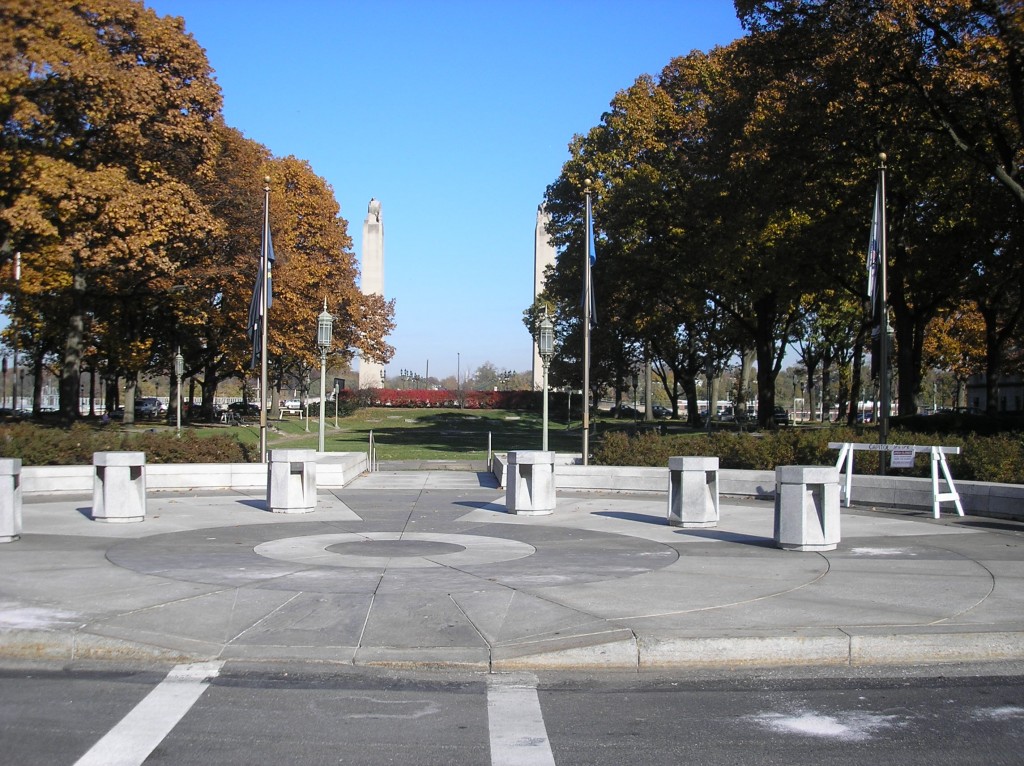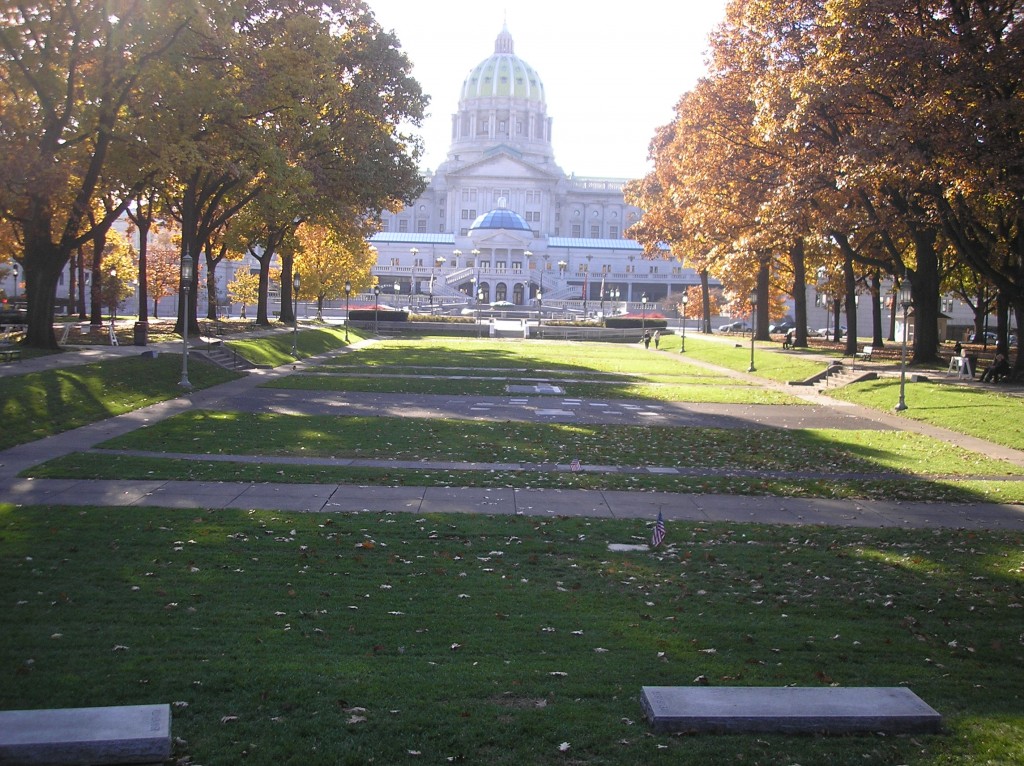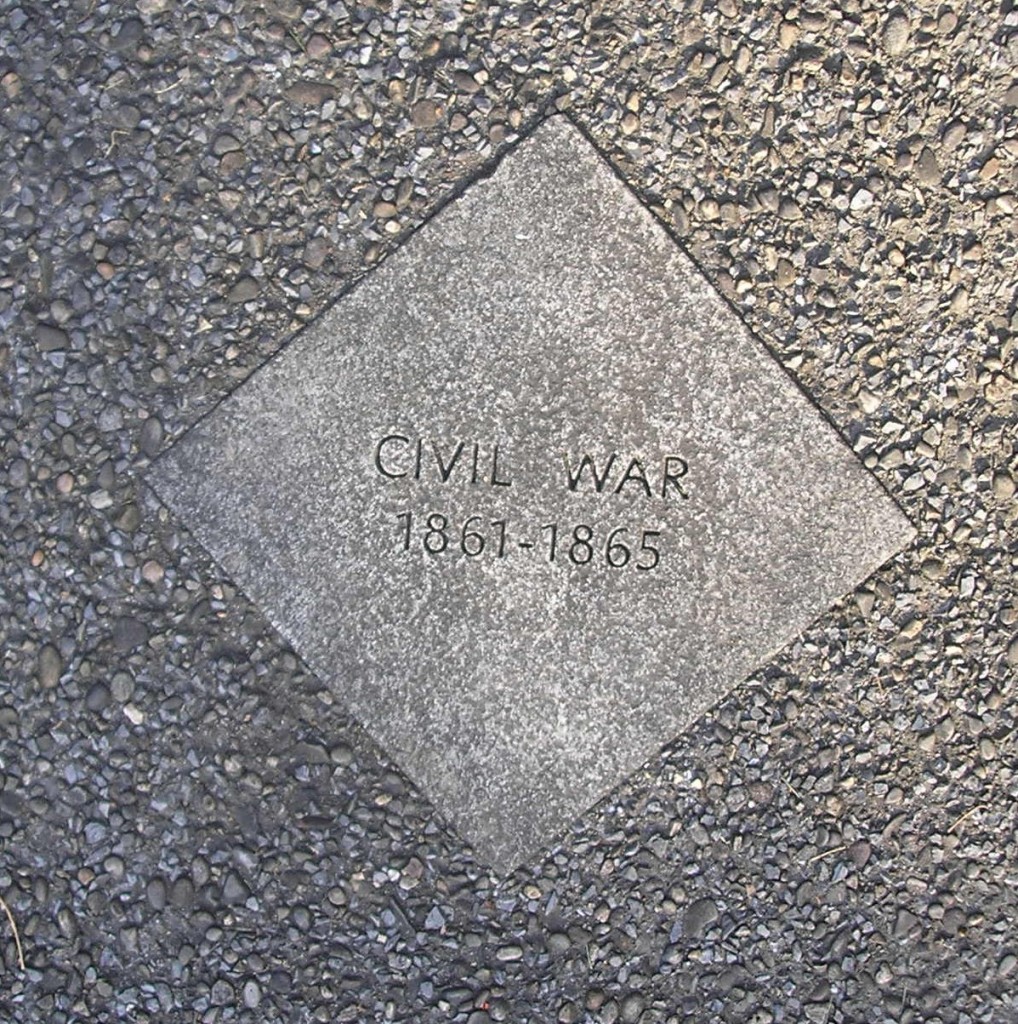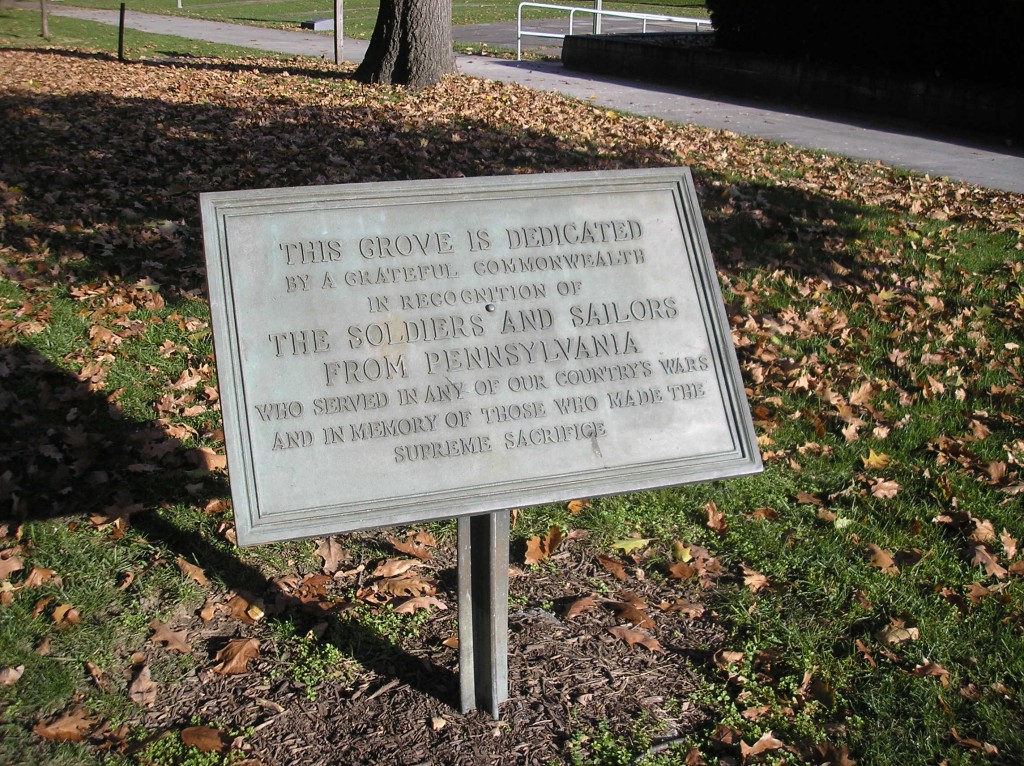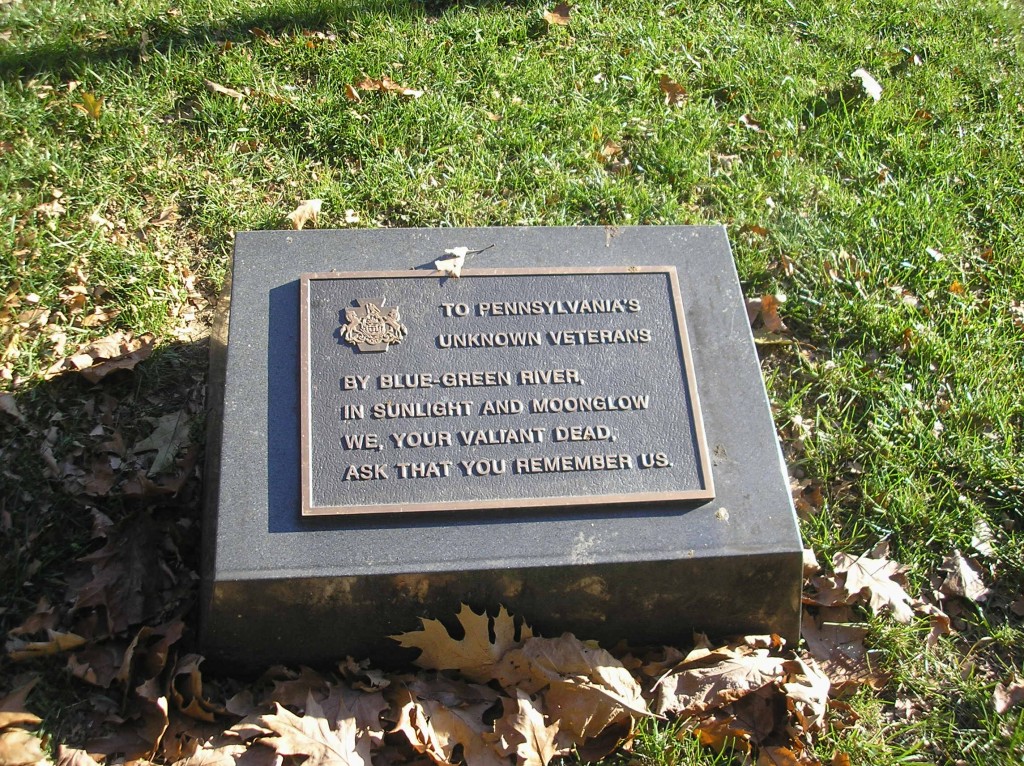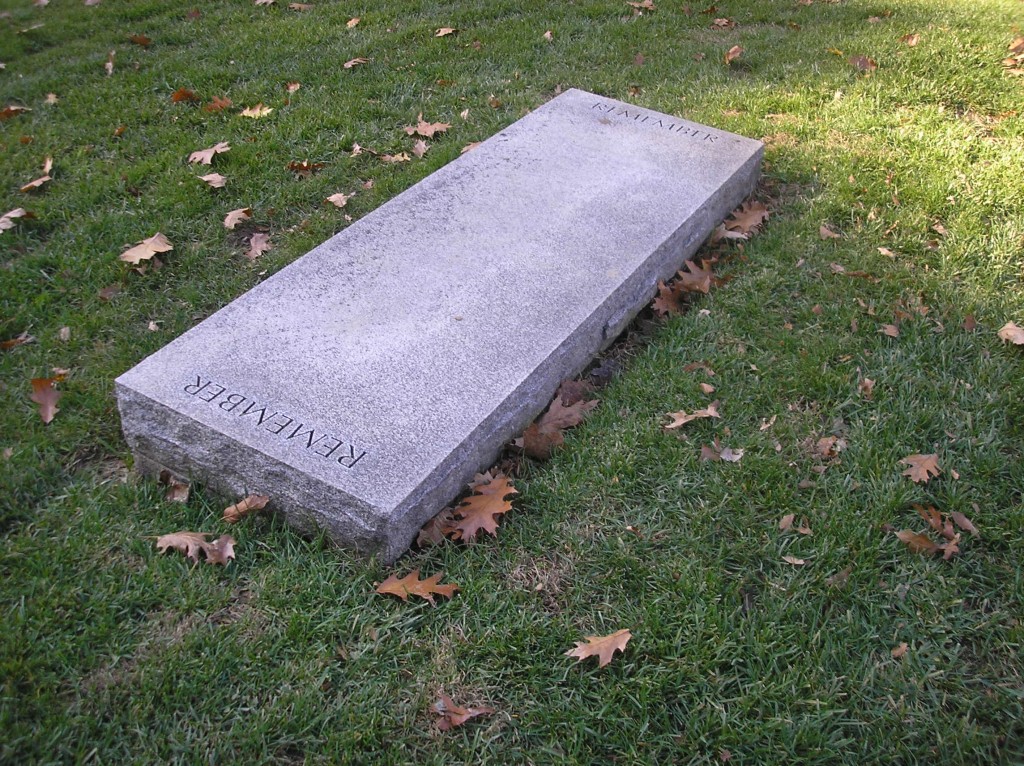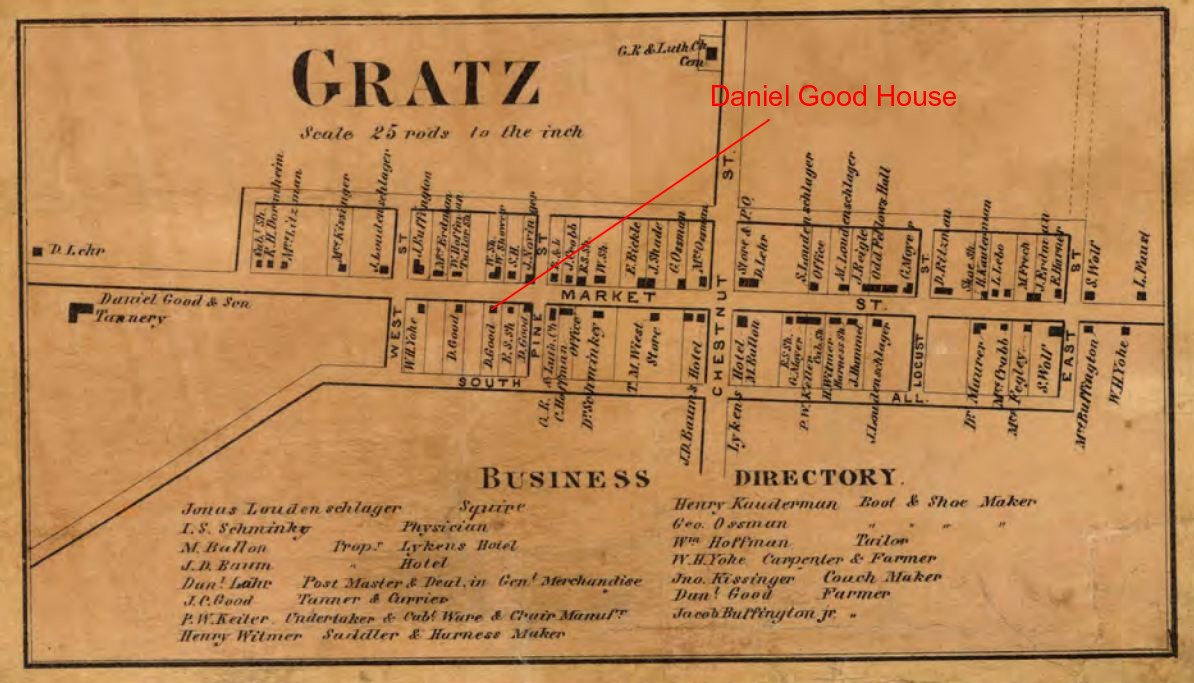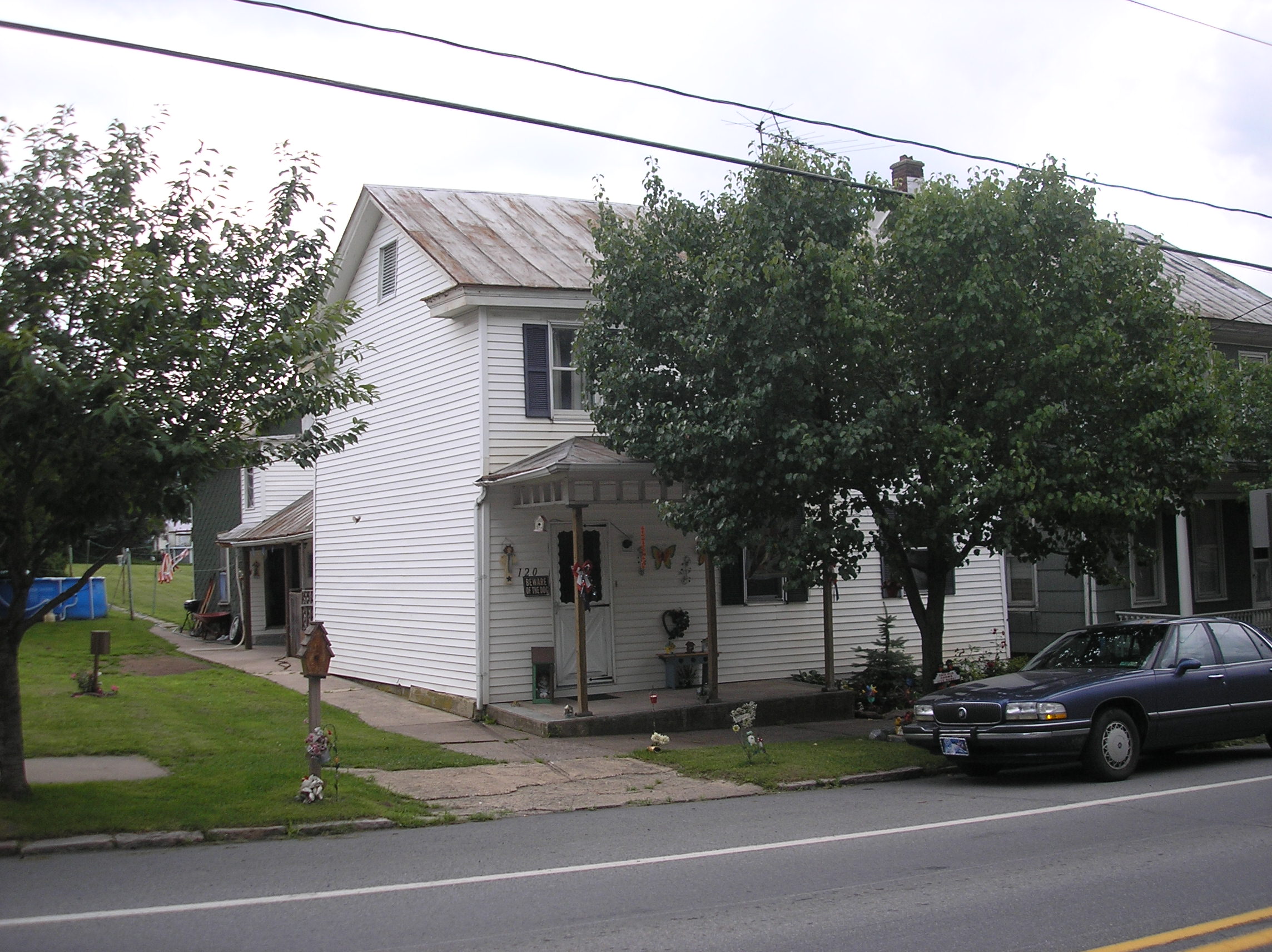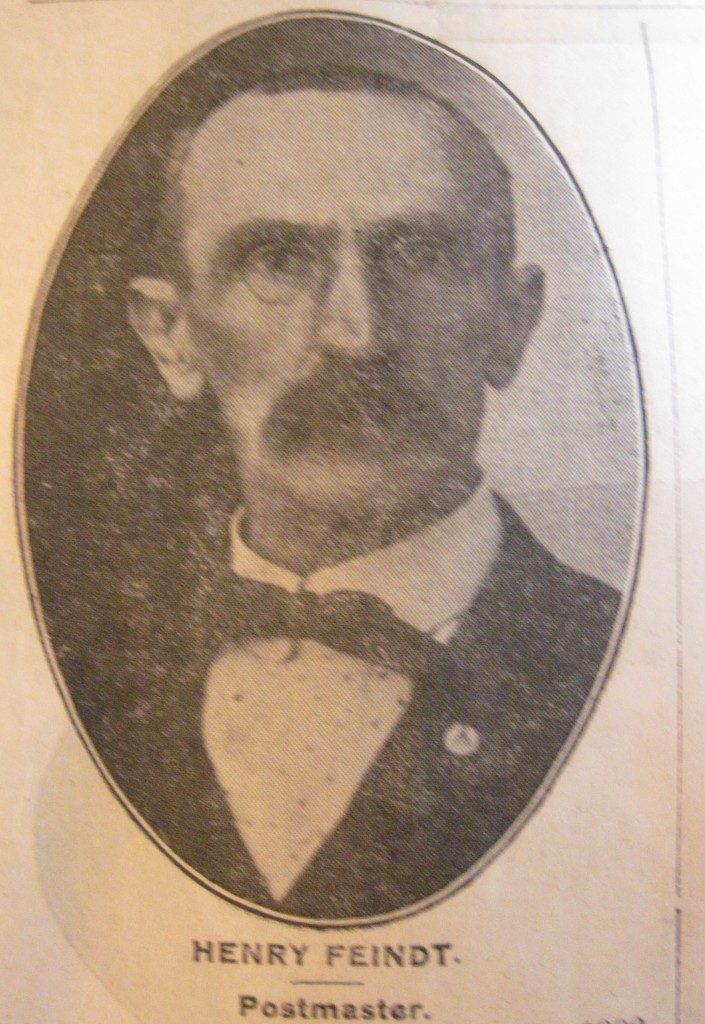Posted By Norman Gasbarro on January 6, 2012
One of the many challenges in researching the individuals who are associated with the Civil War Research Project is in separating the records of men with the same name as other men who also served in Pennsylvania regiments in the Civil War. The case study below presents some of the kinds of records that must be consulted. While the research is by no means completed on any of the three identified men with the name “John Brubaker,” the records that have been consulted provide some measure of separation and give clues as to where more complete information may be located.
The name “John M. Brubaker” first came to the attention of the Civil War Research Project through a veterans’ list found in the bicentennial book that was published for the Halifax area bicentennial. (see Halifax Area Civil War Veterans). The indication was that “John M. Brubaker” was buried in the Halifax United Methodist Cemetery. No Civil War regiments are specified in the list. So the question then becomes, “in which regiment(s) did he serve?”
It has been generally found that when a middle initial is included with a name, it means that the individual used the middle initial to distinguish himself from others of the same name. The first step therefore would be to check the Pennsylvania Archives Veterans’ File Cards – or the Steve Maczuga database of Pennsylvania soldiers – to determine whether there are any persons with the name “John M. Brubaker.”
Two such cards or entries were located in the records. One served with the 9th Pennsylvania Cavalry, Company E, and the other served with the 34th Pennsylvania Infantry, Company K. While checking the records of the 9th Pennsylvania Cavalry, a third record was found for a “John Brubaker” who served in Company B and Company K.
—————————–
Taking the information from the Pennsylvania Archives’ records, it was determined that the John M. Brubaker who served in the 34th Pennsylvania Infantry, Company K, enrolled at Juniata County, Pennsylvania, and was mustered into service at Reading, Berks County, Pennsylvania. He claimed to be 21 years old at enrollment. A Pension Index Card was found for this John M. Brubaker which showed that he applied for a pension but did not receive one. The significance of the Pension Index Card is that this John M. Brubaker only served in the 34th Pennsylvania Infantry; if he had served in another regiment, he would have indicated that fact on his pension application.
The next step is to determine whether this John M. Brubaker has any connection to the Lykens Valley area and whether he should be included in the Civil War Research Project.
First, Find-a-Grave was consulted. There is a John M. Brubaker who is buried in the Otterbein Cemetery, Juniata County, Pennsylvania. The picture of the grave marker gives the birth and death dates (1842-1917) and there is a G.A.R. star-flag holder shown. No regiment is specified on the stone or in the descriptive write-up. We learn though that this John M. Brubaker was married to Hannah Martin (1860-1941) and had a son named Cloyd Brubaker (1880-1897).
This information is then used to help trace this John M. Brubaker through the census and other available records found in Ancestry.com.
In 1860, this John M. Brubaker was a farm laborer, living with his parents, Jacob W. Baker, a farmer, and Elizabeth [Musser] Brubaker in Delaware Township. At the time of the 1863 Civil War Draft, he was a farmer in Delaware Township, Juniata County, and was unmarried. He noted no prior military experience. In 1870, he was working as a farmer in Delaware Township, Juniata County. About 1880, he married Hannah Martin. The 1880 census indicates he was a farmer – still in Delaware Township. He was not located in the 1890 veterans’ enumeration. In 1900, he was living in Thompsontown Borough, Juniata County, and working as a day laborer. In 1910, he was working as a laborer of odd jobs in Delaware Township, Juniata County. At that time, he noted that he was a Union veteran of the Civil War. Hannah [Martin] Brubaker appears in the later census returns as the wife of John M. Brubaker. Two children are also noted: Cloyd O. Baker, who was born 1880 and Harvey E. Brubaker, who was born about 1883.
The military service records at the Pennsylvania Archives and Ancestry.com confirm that this John M. Brubaker was mustered into service on 2 July 1863 and discharged on 10 August 1863 – enough time to claim status as a veteran, but not enough time to claim a pension for service.
The above records also indicate that Hannah survived John by more than 20 years and that she did not apply for a widow’s, perhaps because she would have been rejected for the same reason that John was rejected. Consultation of the pension files at the National Archives would/could produce the reason for the pension rejection as well as other valuable documents that will help to determine more about this John M. Brubaker and whether he had any connection to the Lykens valley area. It does appear though at this time, that there is no evidence that he has any connection to the Lykens Valley area.
JOHN M. BRUBAKER (1842-1917)


—————————–
Next, we will examine the records of the other John M. Brubaker with Pennsylvania Civil War service. First, a check of the available records at the Pennsylvania Archives – and the aforementioned Veterans’ File Card appears (shown below) which indicates service in the 9th Pennsylvania Cavalry, Company E. Going to the Find-a-Grave site, the Halifax Methodist Cemetery record appears with the notation that this John M. Brubaker served in the 9th Pennsyvlania Cavalry, Company E. However, no grave marker picture is provided. This could be because there is no grave marker. The birth and death years are given as 1841 and 1924. There are also two other persons named John Brubaker buried in this cemetery, one with dates 1831-1831 (clearly not a Civil War veteran) and the other with dates 1822-1885, the latter being possible as Civil War veteran, but with no indication of that status in the Find-a-Grave record.
A check of the Pension Index Cards produces a card for Company E of the 9th Pennsylvania Cavalry. There is a pension application and a certificate of award. However, there is no spouse noted on the card.
While the conclusion could be drawn from the above evidence that the John M. Brubaker who appears in the Halifax list is this second one that has now been identified as serving in the 9th Pennsylvania Cavalry, it is always best to trace down other records to determine if there are any unresolved conflicts – and to find out more about this John M. Brubaker who is eligible to be included in this Civil War Research Project.
Ancestry.com records produce information that in 1850, John M. Brubaker was living in Halifax, Dauphin County, with his parents, the father Joseph Brubaker, a tobacconist, and his mother’s name was Martha. A Barbara Brubaker, age 80, was living in the household – probably a grandmother. In 1860, John was still living at home in Halifax and his father Joseph was still a tobacconist.
In 1861, John was working as a school teacher when he enlisted in the 9th Pennsylvania Cavalry at Halifax, Dauphin County (information from the Veterans’ File Card). John served from 17 October 1861 through 24 December 1864, when he was discharged. At the time he would have been given the choice to re-enroll for another three-year term (or duration of the war). Many of his fellow soldiers chose to re-enroll, but apparently John chose to return home to the Halifax area.
In 1870, he appears in Halifax as a school teacher – living with his parents – his father Joseph Brubaker, now a Justice of the Peace. His brothers, Joseph and James, were also living at home and working as tobacconists. In 1880, John M. Brubaker, still unmarried, is a cigar manufacturer in Halifax. In 1890, he appears in the Stark County, Ohio, veterans’ enumeration and in 1910, still in Canton, Stark County, Ohio, he is working as a tinner in a tin shop – with service in the Union army noted – and, still unmarried. In 1920, he appears back in the Lykens Valley area living with a sister in Millersburg, Dauphin County, Lillian K. Straw, a widow, who was working as a fitter in a shoe factory. This later migration to Ohio and then the return to the Lykens Valley area needs further corroborative evidence that it is the same person – but there is a good likelihood that it is. One initially confusing aspect of the research might be the fact that there is no John M. Brubaker named on the Millersburg Civil War Monument; however, it must be noted that the Millersburg Civil War Monument was erected prior to John’s return to the area and his name would not have been included because prior to his moving in with his sister, he had no other known connection to Millersburg.
Some of the documents for this John M. Brubaker are shown below.
JOHN M. BRUBAKER (1841-1924)
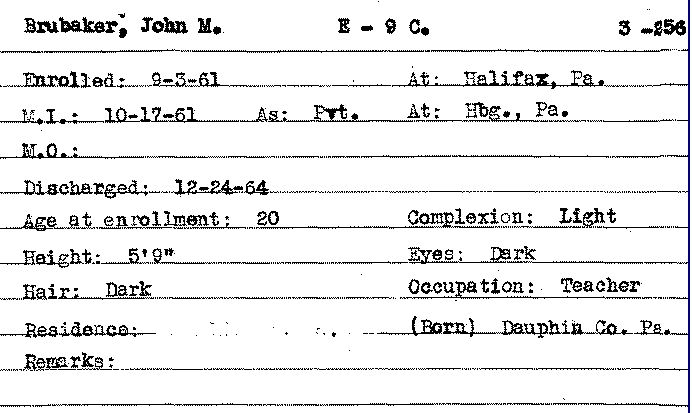

—————————–
The only question now that is left to answer is “who is the other John Brubaker” who served in the 9th Pennsylvania Cavalry?” Tracing this person is a bit more complicated and results in several unanswered questions.
First, an analysis of the Veterans’ File Cards at the Pennsylvania Archives reveals that the John Brubaker who served in the 9th Pennsylvania Cavalry, Company B, enrolled at Millersburg and was mustered in at Camp Cameron (Harrisburg) on 7 October 1861 – to Company B. At some point, a transfer was made to Company K, “by order of Col. Jordan.” A check of the registers of volunteers at the Pennsylvania Archives reveals different information -that the enrollment was at Lykenstown (not Millersburg) and that John Brubaker was 23 years old at the time – not 26 as is stated on the Veterans’ File Card. If he enrolled at either place, his name does not appear on either monument – the one at Millersburg or the one at Lykens. This regiment, the 9th Pennsylvania Cavalry, and the specific Company B, was heavily composed of men from the Lykens Valley area.
The discharge date of 24 December 1864 is consistent with the end of a three-year term of service, and as noted above with the John M. Brubaker who served in Company E, this John Brubaker chose to go home rather than re-enlist.
No Pension Index Card has been located for the John Brubaker who served in the 9th Pennsylvania Cavalry, Company B or Company K.
In the records of the Maple Grove Cemetery in Elizabethville, Dauphin County, there is a John R. Brubaker with a G.A.R. notation, but with no regiment specified. Is this the John Brubaker who served in Company B & Company K of the 9th Pennsylvania Cavalry? There is no entry in Find-a-Grave for an individual named John Brubaker who is buried in this cemetery.
In further tracing the John Brubaker who is supposedly buried in Elizabethville (his grave marker has not yet been located), is can be determined that this John Brubaker was married to Margaret Ellen Poffenberger, was born around 1845 and died around 1923. The birth year does not seem to match either possible date (age 26 in 1861 – or age 23 in 1861) for the John Brubaker who served in the 9th Pennsylvania Cavalry, Company B and Company K.
In what appears to be the same person as the one buried in Elizabethville, John R. Brubaker is living in Halifax in 1910 and working as a farmer. He is divorced and a son Harry is living with him. Harry Brubaker is working as a school teacher. More significantly, no service in the Union army is noted! Furthermore, no record has been found for this John R. Brubaker in the 1890 veterans’ enumeration.
Without question, a John Brubaker served in Companies B and K of the 9th Pennsylvania Cavalry. We know that most of the members of Company B were from the Lykens Valley area. What we don’t know is why the transfer to Company K occurred and what happened to this John Brubaker after the war. If he is the same person who is supposedly buried in Elizabethville as “G.A.R.”, why can’t other evidence be located to connect him to his regiment? Without a Pension Index Card and 1890 census return showing Civil War service in these companies, it is very difficult to have a good match.
A check of the history of the 9th Pennsylvania Cavalry (Yankee Cavalrymen) produced no results.
The final step in the process will be to try to locate other records. Perhaps an obituary can be located. Tracing his descendants is another option. But, by tracing John R. Brubaker, a dead end could be reached with no evidence of Civil War service located. The only option may be to go to the actual muster roll- or official military records – to see if there is any mention of this John Brubaker.
Finally, perhaps a reader of this blog could she some light on John Brubaker.
The Veterans’ File Card is shown below.
JOHN BRUBAKER (1845?-1923?)
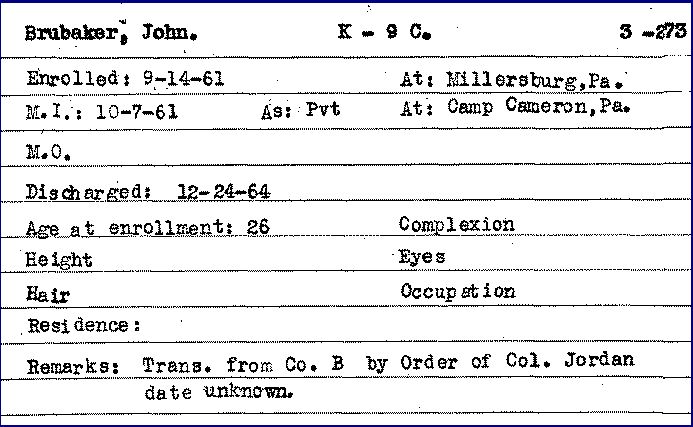
This post points out a major problem in determining the identity and service of men of similar names who served in the Civil War. It is possible that these men were related to each other and knew of each other at the time. But it is also possible that there is no genealogical connection. One of the most rewarding aspects of research is discovering long-lost information and recording stories for posterity. If anyone can shed light on any of these individuals, they are urged to come forward.
Pennsylvania Veterans’ File Cards are from the Pennsylvania Archives. Pension Index Cards, which refer to files in the National Archives, are from Ancestry.com
Category: Queries, Research, Stories |
Comments Off on Who Was John Brubaker?
Tags: Brubaker family, Elizabethville, G.A.R., Halifax, Halifax Township, Lykens Borough, Millersburg, Regiments


 ;
;
